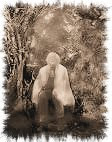Christian mysticism is the pursuit of communion with, identity with, or conscious awareness of God through direct experience, intuition, instinct or insight. Christian mysticism usually centers on a practice or practices intended to nurture those experiences or awareness, such as deep prayer (i.e. meditation, contemplation) involving the person of Jesus Christ and the Holy Ghost. This approach and lifestyle is distinguished from other forms of Christian practice by its aim of achieving unity with the divine. In the words of Oswald Chambers, "We receive His blessings and know His Word, but do we know Him?"[1]
Whereas Christian doctrine generally maintains that God dwells in all people and that they can experience God directly through belief in Jesus,[2] Christian mysticism aspires to apprehend spiritual truths inaccessible through intellectual means, typically by learning how to think like Christ. William Inge divides this scala perfectionis into three stages: the "purgative" or ascetic stage, the "illuminative" or contemplative stage, and the "unitive" stage, in which God may be beheld "face to face".[3]
In the tradition of Mystical Theology, Biblical texts are typically interpreted allegorically; for example in Jesus' "Sermon on the Mount" (Matthew 5–7) the text, in its totality, is held to contain the way for direct union with God. Also, in the contemplative and eremitic tradition of the Carmelite "Book of the First Monks", 1 Kgs. 17:3-4 is the central Biblical text around which the work is written.
Within the broad spectrum of religious groups, it is believed that the spirit of man lost its original connection with God. The spirit of man longs to find this connection again and to intimately experience God. Although orthodox Christianity teaches that this connection can only be restored via the blood of Jesus Christ through His sacrificial death, mysticism teaches alternative or supplementary spiritual practices as a way to restore the relationship between God and man. These practices includes meditation, purification and works of love. Christian mysticism teaches these practices finding biblical support, sometimes disregarding the blood of Jesus as the only means to access God directly (Heb 10:19,20).
Biblical foundations
The tradition of Christian Mysticism is as old as Christianity itself. At least three texts from the New Testament set up themes that recur throughout the recorded thought of the Christian mystics. The first, Galatians 2:20, says that:I am crucified with Christ: nevertheless I live; yet not I, but Christ liveth in me, and the life which I now live in the flesh I live by the faith of the Son of God, who loved me, and gave Himself for me. (KJV)Another important scriptural text for Christian mysticism is 1 John 3:2:
Beloved, now we are the sons of God, and it doth not yet appear what we shall be: but we know that, when He shall appear, we shall be like Him; for we shall see Him as He is.The third such text, especially important for Eastern Christian mysticism, is found in 2 Peter 1:4:
...[E]xceedingly great and precious promises [are given unto us]; that by these ye might be partakers of the divine nature, having escaped the corruption that is in the world through lust. (emphasis added)Two major themes of Christian mysticism are (1) a complete identification with or imitation of Christ, to achieve a unity of the human spirit with the spirit of God; and (2) the perfect vision of God, in which the mystic seeks to experience God "as he is," rather than "through a glass, darkly." (1 Corinthians 13:12)
Other mystical experiences are described in other passages. In 2 Corinthians 12:2–4, Paul sets forth an example of a possible out-of-body experience by someone (whom tradition says was St. Paul himself, who wrote in the third person out of modesty) who was taken up to the "third heaven", and taught unutterable mysteries:
I knew a man in Christ above fourteen years ago, (whether in the body, I cannot tell; or whether out of the body, I cannot tell: God knoweth;) such an one caught up to the third heaven. And I knew such a man, (whether in the body, or out of the body, I cannot tell: God knoweth;) how that he was caught up into paradise, and heard unspeakable words, which it is not lawful for a man to utter.Perhaps a similar experience occurred at the Transfiguration of Jesus, an incident confirmed in each of the Synoptic Gospels. Here Jesus led three of his apostles, Peter, John, and James, to pray at the top of a mountain, where he became transfigured. Jesus's face shone like the sun, and he was clad in brilliant white clothes. Elijah and Moses appeared with Jesus, and talked with him, and then a bright cloud appeared overhead, and a voice from the cloud proclaimed, "This is my beloved Son: hear him."
Practice
For Christians the major emphasis of mysticism concerns a spiritual transformation of the egoic self, the following of a path designed to produce more fully realized human persons, "created in the Image and Likeness of God" and as such, living in harmonious communion with God, the Church, the rest of humanity, and all creation, including oneself. For Christians, this human potential is realized most perfectly in Jesus, precisely because he is both God and human, and is manifested in others through their association with him, whether conscious, as in the case of Christian mystics, or unconscious, with regard to spiritual persons who follow other traditions, such as Gandhi. The Eastern Christian tradition speaks of this transformation in terms of theosis or divinization, perhaps best summed up by an ancient aphorism usually attributed to Athanasius of Alexandria: "God became human so that man might become god."Going back at least to Evagrius Ponticus and Pseudo-Dionysius, Christian mystics have pursued a threefold path in their pursuit of holiness. While the three aspects have different names in the different Christian traditions, they can be characterized as purgative, illuminative, and unitive, corresponding to body, soul (or mind), and spirit. The first, the way of purification, is where aspiring Christian mystics start. This aspect focuses on discipline, particularly in terms of the human body; thus, it emphasizes prayer at certain times, either alone or with others, and in certain postures, often standing or kneeling. It also emphasizes the other disciplines of fasting and alms-giving, the latter including those activities called "the works of mercy," both spiritual and corporal, such as feeding the hungry and sheltering the homeless.
Purification, which grounds Christian spirituality in general, is primarily focused on efforts to, in the words of St. Paul, "put to death the deeds of the flesh by the Holy Spirit" (Romans 8:13). The "deeds of the flesh" here include not only external behavior, but also those habits, attitudes, compulsions, addictions, etc. (sometimes called egoic passions) which oppose themselves to true being and living as a Christian not only exteriorly, but interiorly as well. Evelyn Underhill describes purification as an awareness of one's own imperfections and finiteness, followed by self-discipline and mortification. Because of its physical, disciplinary aspect, this phase, as well as the entire Christian spiritual path, is often referred to as "ascetic," a term which is derived from a Greek word which connotes athletic training.
Because of this, in ancient Christian literature, prominent mystics are often called "spiritual athletes," an image which is also used several times in the New Testament to describe the Christian life. What is sought here is salvation in the original sense of the word, referring not only to one's eternal fate, but also to healing in all areas of life, including the restoration of spiritual, psychological, and physical health.
It remains a paradox of the mystics that the passivity at which they appear to aim is really a state of the most intense activity: more, that where it is wholly absent no great creative action can take place. In it, the superficial self compels itself to be still, in order that it may liberate another more deep-seated power which is, in the ecstasy of the contemplative genius, raised to the highest pitch of efficiency. Mysticism: A Study in Nature and Development of Spiritual Consciousness by Evelyn Underhill (Public Domain)
The second phase, the path of illumination, has to do with the activity of the Holy Spirit enlightening the mind, giving insights into truths not only explicit in scripture and the rest of the Christian tradition, but also those implicit in nature, not in the scientific sense, but rather in terms of an illumination of the "depth" aspects of reality and natural happenings, such that the working of God is perceived in all that one experiences. Underhill describes it as marked by a consciousness of a transcendent order and a vision of a new heaven and a new earth.
The third phase, usually called contemplation in the Western tradition, refers to the experience of oneself as in some way united with God. The experience of union varies, but it is first and foremost always associated with a reuniting with Divine love, the underlying theme being that God, the perfect goodness,[4] is known or experienced at least as much by the heart as by the intellect since, in the words 1 John 4:16: "God is love, and he who abides in love abides in God and God in him." Some approaches to classical mysticism would consider the first two phases as preparatory to the third, explicitly mystical experience, but others state that these three phases overlap and intertwine.
Author and mystic Evelyn Underhill recognizes two additional phases to the mystical path. First comes the awakening, the stage in which one begins to have some consciousness of absolute or divine reality. Purgation and illumination are followed by a fourth stage which Underhill, borrowing the language of St. John of the Cross, calls the dark night of the soul. This stage, experienced by the few, is one of final and complete purification and is marked by confusion, helplessness, stagnation of the will, and a sense of the withdrawal of God's presence. It is the period of final "unselfing" and the surrender to the hidden purposes of the divine will. Her fifth and final stage is union with the object of love, the one Reality, God. Here the self has been permanently established on a transcendental level and liberated for a new purpose.[5]
Another aspect of traditional Christian spirituality, or mysticism, has to do with its communal basis. Even for hermits, the Christian life is always lived in communion with the Church, the community of believers. Thus, participation in corporate worship, especially the Eucharist, is an essential part of Christian mysticism. Connected with this is the practice of having a spiritual director, confessor, or "soul friend" with which to discuss one's spiritual progress. This person, who may be clerical or lay, acts as a spiritual mentor.
See also
- List of Christian mystics
- Behmenism
- Christian Kabbalah
- Christian meditation
- Christian Mysticism in Ancient Africa
- Esoteric Christianity
- German mysticism
- Hesychasm
- Jesus Prayer
- Mystical marriage
- Mystical theology
- Quietism (Christian philosophy)
- Spanish mystics
- Starets
- Notes and references
- ^ http://search.barnesandnoble.com/My-Utmost-for-His-Highest/Oswald-Chambers/e/9781572931589
- ^ John 7:16–39
- ^ Christian Mysticism (1899 Bampton Lectures)
- ^ Theologia Germanica, public domain
- ^ Greene, Dana, "Adhering to God: The Message of Evelyn Underhill for Our Times", Spirituality Today, Spring 1987, Vol. 39, pp. 22–38
Bibliography
- Bernard McGinn: The Foundations of Mysticism: Origins to the Fifth Century, 1991, reprint 1994, ISBN 0-8245-1404-1
- Bernard McGinn: The Growth of Mysticism: Gregory the Great through the 12th Century, 1994, paperback ed. 1996, ISBN 0-8245-1628-1
- Evelyn Underhill: Mysticism: A Study in Nature and Development of Spiritual Consciousness, 1911, reprint 1999, ISBN 1-85168-196-5 online edition
- Tito Colliander: Way of the Ascetics, 1981, ISBN 0-06-061526-5
- Thomas E. Powers: Invitation to a Great Experiment: Exploring the Possibility that God can be Known, 1979, ISBN 0-385-14187-4
- Richard Foster: Celebration of Discipline: The Path to Spiritual Growth, 1978, ISBN 0-06-062831-6
- Classics
- St. John of the Cross: Ascent of Mount Carmel, Dark Night of the Soul
- St. Teresa of Avila: Interior Castle, The Way of Perfection, Autobiography
- St. Bonaventure: The Soul's Journey into God, The Tree of Life
- Meister Eckhart: German and Latin sermons
- Jan van Ruysbroeck: The Adornment of Spiritual Marriage
- Anon.: Cloud of Unknowing
- Anon.: Theologia Germanica
- St.Ignatius of Loyola: Spiritual Exercises
- William Law: Works
- George Fox: The Journal
- Heinrich Suso: The Book of Eternal Wisdom
- Thomas à Kempis: On the Imitation of Christ
- Jakob Lorber: The Great Gospel of John
- Pseudo-Dionysius: Divine Names, Celestial Hierarchy, Mystical Theology
- Philokalia
- Anon.: The Way of a Pilgrim
External links
 "Mysticism" in the 1913 Catholic Encyclopedia.
"Mysticism" in the 1913 Catholic Encyclopedia.- Underhill's "Historical Sketch" of Christian Mysticism from Mysticism (1911)
Dear Readers, please do not assume that you understand anything you read on this blog.


.jpg)

.jpg)
.jpg)


